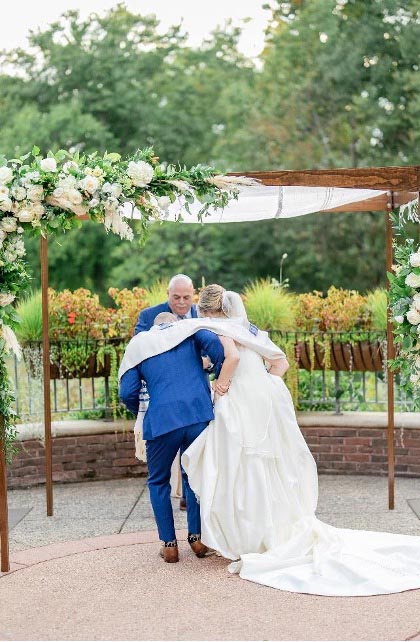
Candles are often used in processionals. Consider an alternative of each of the couple lighting a Shabbat candle; the pair of lit candles recalls the light of regular holy time. Another option is lighting a multi-wicked Havdalah candle, symbolizing the unity of its light despite its many sources, much in the way a family is the culmination of many ancestors to a particular point. Some interfaith couples like the idea of lighting a unity candle, making the statement that all family traditions are welcomed and honored.
Circling has many ancient sources. Traditionally a bride might circle a groom three or seven times. Mutual circling has become more common. Some celebrations have each primary circle the other three times, and then the wedding party encircle them. The 3+3+1=7 has deep power!
Family Judaica, whether new or heirloom, always has a place in a wedding ceremony. Candlesticks and kiddush cups are regularly used by couples. Sometimes there are two cups, one from the past for the first set of wedding blessings, and one a new gift for the couple for the final Sheva Brachot/7 Blessings. Some families even have their own huppah-wedding canopy, like in the photograph! It was built by the groom, and a beloved heirloom tallit (prayer shawl) is used as part of the roof. Sometimes a tallit is hung more as a banner. Your preferences rule!
The typical double-ring ceremony allows for many variations. There are options for the language one might use. It is a perfect opportunity to share personal statements and covenants; the traditional Jewish wedding doesn’t really do “vows.” Special poems, readings, and musical selections can always be worked into a ceremony. Consult with your officiant on how to make that happen!
An ancient custom finding regular use is to enwrap the couple in a tallit for the final Sheva Brachot/7 Blessings. Also, the Sheva Brachot themselves are an opportunity for personalization. Having capable family or friends to chant the blessings, or recite the translation, is always a powerful experience!
5 Things to Consider
Some venues disallow open flames; ensure they are allowed by the venue!
If using candles, make sure you have a new lighter, or fresh matches available.
Don’t forget the logistics of a wedding dress when considering circling! Will a train need to be gathered, or even supported by an attendant?
Make sure that personal Judaica items are marked and identifiable. Ideally someone is on point to collect them after the ceremony for safe keeping.
Make sure anyone being asked into a part is given a copy for advance practice, even if just one line in English!
